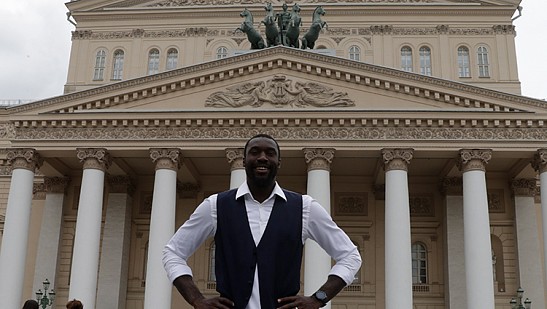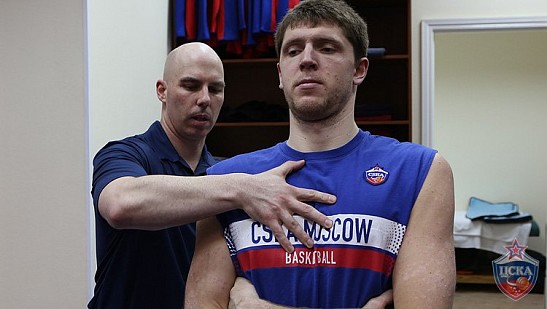Offence: transition
05.02.2007
When one watches the game for the first several times, it is hard to get focused on anything else then the ball moves. The team that has the ball is in the offence and that is why our current topic is the offence. Today we will have the assistance from the head coach of CSKA second team Andrei Maltsev...

When one watches the game for the first several times, it is hard to get focused on anything else then the ball moves. The team that has the ball is in the offence and that is why our current topic is the offence. Today we will have the assistance from the head coach of CSKA second team Andrei Maltsev.
The goal of every team action in the offence is to create the situation for one of the players to shoot from the most comfortable (for him) position on the court with minimum resistance of the defense.
Of course, the easiest way to create the kind of situation is when the team has more players in the offence then the rival in the defense. Numerical superiority mostly happens in the fast play when the defensive players are not on time to get back to their side of the court. The action we would talk about takes just several seconds so the speed of the players is close to their personal maximum. And of course the team should be in shape. The name of the offensive strategy is the transition.
For the transition strategy to be effective, the team should follow several rules. One can easily see if one team does it or not. The classical situations in the transition are when the offensive team has one player more then the rival. Let’s take a closer look on the actual situations that may occur.
1 player of the offensive team – 0 in defense: If the player has the ball he has to find the best shooting position himself. The only limit is time. Other 9 players would not wait for him to score from the best possible position.
In case some other player of the team on the other side of the court has the ball he should pass it. The best way is to pass it to the wing or to the low post so the attacker would not have to make any extra moves other then to shoot or make two steps to the basket.
2 players in offense – 1 player in defense: Here and below a lot depends on the positions of the players who take part in the action. Of course, between two offensive players, the defender would have the closer look to the one who has the ball. That is the reason why in such actions it is better to make several fast passes between two before getting to the other side of the court. But the passes should not take the extra time.
The two players should not drive to the opposite basket close to each other. Otherwise it would be easier for the defender to limit their scoring opportunities. It is better if the two are on the two different sides from the hoop but of course not too close to the side line.
The player with the ball should dribble the ball on the opposite side from the defender and it is also up to him to decide what to do: to try to score himself, to play one-on-one with the defender and to drive to the basket, to pass the ball to his teammate and so on. The best decision of course can be taken depending on the defenders actions.

3 players in the offence – 2 in the defense: Obtuse triangle with long faces is the best team picture in the kind of transition play. The obtuse angle is the player with the ball so he can see both of his teammates. For example one of the players can stay on the wing. The player with the ball can be in the elbow on the same side and the third offender a bit closer then the 3-point line on the opposite side. So the player with the ball has maximum possible variations of the play. The final decision depends on the defending players’ moves and on the individual abilities of his partners.

4 players of the offence – 3 in the defense: This kind of situation occurs rarely and has more variations. But the rules are the same. To play as wide as possible, pay attention to the defenders actions and to keep as much as possible ways to continue the offensive possession.
The points scored in transition can give the team the advantage. The fast transition play some times can bring the key points of the game. It is a bit easier to score: as usual the defense makes more mistakes in the first seconds of the possession. The team without dominate center can hide the weakness with the fast transition play. And the last one: in case of transition failure there is a chance to organize the regular possession with all of the players on the one side of the court.
The goal of every team action in the offence is to create the situation for one of the players to shoot from the most comfortable (for him) position on the court with minimum resistance of the defense.
Of course, the easiest way to create the kind of situation is when the team has more players in the offence then the rival in the defense. Numerical superiority mostly happens in the fast play when the defensive players are not on time to get back to their side of the court. The action we would talk about takes just several seconds so the speed of the players is close to their personal maximum. And of course the team should be in shape. The name of the offensive strategy is the transition.
For the transition strategy to be effective, the team should follow several rules. One can easily see if one team does it or not. The classical situations in the transition are when the offensive team has one player more then the rival. Let’s take a closer look on the actual situations that may occur.
1 player of the offensive team – 0 in defense: If the player has the ball he has to find the best shooting position himself. The only limit is time. Other 9 players would not wait for him to score from the best possible position.
In case some other player of the team on the other side of the court has the ball he should pass it. The best way is to pass it to the wing or to the low post so the attacker would not have to make any extra moves other then to shoot or make two steps to the basket.
2 players in offense – 1 player in defense: Here and below a lot depends on the positions of the players who take part in the action. Of course, between two offensive players, the defender would have the closer look to the one who has the ball. That is the reason why in such actions it is better to make several fast passes between two before getting to the other side of the court. But the passes should not take the extra time.
The two players should not drive to the opposite basket close to each other. Otherwise it would be easier for the defender to limit their scoring opportunities. It is better if the two are on the two different sides from the hoop but of course not too close to the side line.
The player with the ball should dribble the ball on the opposite side from the defender and it is also up to him to decide what to do: to try to score himself, to play one-on-one with the defender and to drive to the basket, to pass the ball to his teammate and so on. The best decision of course can be taken depending on the defenders actions.

3 players in the offence – 2 in the defense: Obtuse triangle with long faces is the best team picture in the kind of transition play. The obtuse angle is the player with the ball so he can see both of his teammates. For example one of the players can stay on the wing. The player with the ball can be in the elbow on the same side and the third offender a bit closer then the 3-point line on the opposite side. So the player with the ball has maximum possible variations of the play. The final decision depends on the defending players’ moves and on the individual abilities of his partners.

4 players of the offence – 3 in the defense: This kind of situation occurs rarely and has more variations. But the rules are the same. To play as wide as possible, pay attention to the defenders actions and to keep as much as possible ways to continue the offensive possession.
The points scored in transition can give the team the advantage. The fast transition play some times can bring the key points of the game. It is a bit easier to score: as usual the defense makes more mistakes in the first seconds of the possession. The team without dominate center can hide the weakness with the fast transition play. And the last one: in case of transition failure there is a chance to organize the regular possession with all of the players on the one side of the court.















